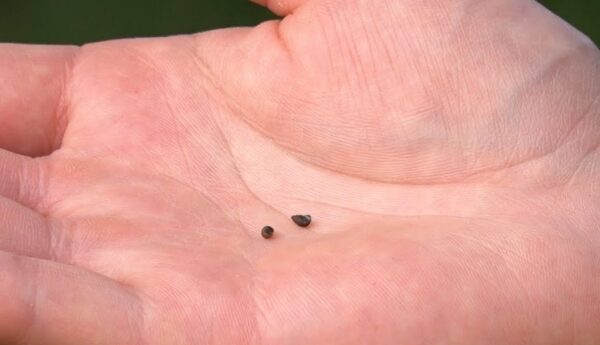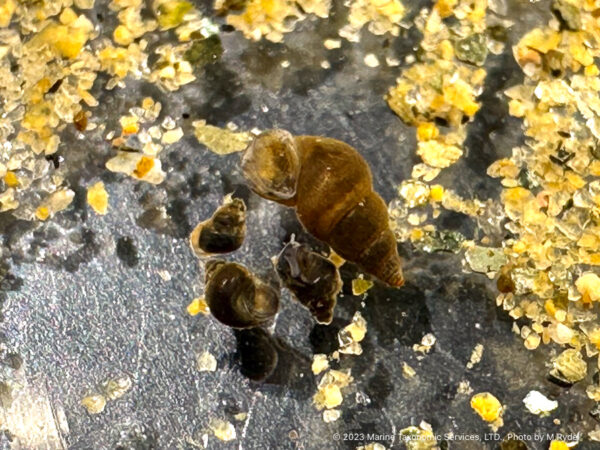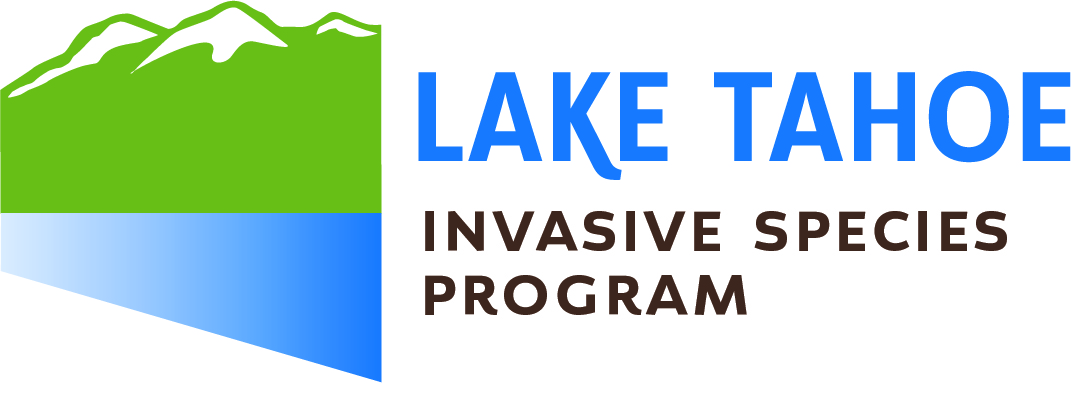Lake Tahoe, CA/NV – Divers monitoring Lake Tahoe have discovered invasive New Zealand mudsnails in areas off the South Shore, the Tahoe Regional Planning Agency (TRPA) and Tahoe Resource Conservation District (Tahoe RCD) announced today. This is the first time the species has been detected in the Tahoe Basin.
Get the fact sheet here.

Invasive New Zealand mudsnails have been discovered in Lake Tahoe, a highly protected alpine lake on the California/Nevada border. Image Credit: Michigan Department of Natural Resources
The Lake Tahoe Aquatic Invasive Species Program includes comprehensive monitoring of Lake Tahoe for aquatic invaders. Contract divers with Marine Taxonomic Services, Ltd. surveying invasive weeds on the South Shore discovered tiny snails on the bottom of the lake nearly a half mile offshore from the mouth of the Upper Truckee River. Consultation with experts and a DNA lab analysis confirmed the species is New Zealand mudsnail, an aquatic invasive species (AIS) that has been detected in nearby waterways including the Lower Truckee River downstream from Lake Tahoe near Reno, Nevada. No other AIS, such as the destructive quagga and zebra mussel, have been detected, according to the agencies.
Following rapid response protocols under the federally approved Lake Tahoe Aquatic Invasive Species Management Plan, TRPA convened an incident team comprised of staff from TRPA and Tahoe RCD and partner experts. The team is rapidly deploying scientists, beginning with lake-wide dive surveys to determine the extent of the infestation and sharing all available information with state and federal wildlife managers through the Lake Tahoe Aquatic Invasive Species Coordinating Committee. For continued updates and information, visit the New Zealand mudsnail page.
“Lake Tahoe is one of the most protected waterbodies in the United States and our aquatic invasive species monitoring program is credited as the reason for this concerning discovery,” TRPA Executive Director Julie Regan said. “It is critical that everyone remain vigilant and adhere to the mantra of Clean, Drain, and Dry. Every boater, paddler, and angler shares the responsibility to protect Lake Tahoe’s native species and the waters we enjoy.”
As climate change continues to affect Lake Tahoe’s native ecosystem, the threat of new invasive species taking hold in the region is increasing. . Under the Lake Tahoe Environmental Improvement Program, the AIS Program is helping protect water quality and native species and is a key program to improve the climate resilience of the region, according to TRPA.
Invasive species can be carried on boats, fishing gear, paddle craft, life vests, and beach toys, according to the national Stop Aquatic Hitchhikers! campaign. The most effective way to prevent their spread is to Clean, Drain, and Dry boats and gear before entering a new waterbody.

New Zealand mudsnails found in Lake Tahoe, shown with sand particles from the lake. Credit: Marine Taxonomic Services, Ltd.
Since 2008, the Lake Tahoe AIS Program has served as the national model and maintained one of the lowest risk profiles in the nation for introduction of new invasive species.
“Lake Tahoe’s robust watercraft inspection program, and commitment from the public, shows that preventing the spread of aquatic invasive species is possible,” said Lisa Heki, Lahontan National Fish Hatchery Complex Project Leader, U.S. Fish and Wildlife Service. “Now more than ever, we have to support and strengthen our work with anglers, boaters, paddlers, and everyone who interacts with the waters of Lake Tahoe and its 63 tributaries.”
Periodic monitoring for invasive species in the basin is an integral part of the Lake Tahoe AIS Management Plan. Early detection and rapid response also helps agencies control the spread of aquatic invasive weeds that were introduced before the inspection program, such as the ongoing weed removal project in Emerald Bay.
“Lake Tahoe has a well-established network of regional and national partnerships that are all working together to reduce the threat of AIS,” TRPA Aquatic Invasives Species Program Manager and incident team co-lead Dennis Zabaglo said. “The incident team and our partners are dedicated to protecting Lake Tahoe and will be working together to evaluate options for responding to this new finding.”
TRPA advocated for federal funds to be set aside for early detection and rapid response actions throughout the nation. Tahoe agencies are using critical federal funds to address the New Zealand mudsnail introduction.
Get up-to-date information on the response and potential protocols for management of the infestation on the TRPA New Zealand mudsnail page.
Invasive New Zealand mudsnails are notoriously difficult to detect due to their size, shown with a U.S. dime coin. Credit: U.S. Geological Survey of new invasive species
About New Zealand mudsnails
Not to be confused with highly destructive quagga and zebra mussels which have not been detected in Lake Tahoe, New Zealand mudsnails are often smaller than a grain of rice (2-6 mm). Like many AIS, without natural predators or controls, they can outcompete native species and harm ecosystem functions. First discovered in 1987 in Idaho, New Zealand mudsnails are currently found in 22 states including California and Nevada. They are able to colonize new waters quickly and due to their small size are difficult to detect. More information on the species is available from the U.S. Geological Survey.
About the Lake Tahoe Watercraft Inspection Program
TRPA and Tahoe RCD initiated the Lake Tahoe watercraft inspection program in 2008 when quagga and zebra mussels were discovered in Lake Mead, just 300 miles from the basin. Under the Lake Tahoe Environmental Improvement Program, more than 107,000 vessels have been inspected since the start of the program, which is considered a gold standard for the nation. Strict protocols reduce the risk posed by watercraft of spreading these species by requiring every vessel to be decontaminated that is known to have been in water associated with New Zealand mudsnails or other AIS. This process is enforced for both motorized and non-motorized watercraft at all ramps, launches, and staffed public beaches. Vessels visiting Echo and Fallen Leaf Lakes are required to be decontaminated regardless of where they have been.
Learn more about the watercraft inspection program and how to Clean, Drain, and Dry at tahoeboatinspections.com. Paddlers, anglers, and other non-motorized watercraft users have many resources available at tahoekeepers.org.
###
 The Lake Tahoe Aquatic Invasive Species Program is implemented by 40 public and private partner organizations, including federal, state, and local jurisdictions, research partners, public utility districts, and private marinas. The Tahoe Regional Planning Agency and the Tahoe Resource Conservation District lead the program in collaboration with the public and private partners. The program’s mission is to prevent, detect, and control aquatic invasive species in the Region so that future generations can enjoy Lake Tahoe.
The Lake Tahoe Aquatic Invasive Species Program is implemented by 40 public and private partner organizations, including federal, state, and local jurisdictions, research partners, public utility districts, and private marinas. The Tahoe Regional Planning Agency and the Tahoe Resource Conservation District lead the program in collaboration with the public and private partners. The program’s mission is to prevent, detect, and control aquatic invasive species in the Region so that future generations can enjoy Lake Tahoe.
The Tahoe Regional Planning Agency leads the cooperative effort to preserve, restore, and enhance the unique natural and human environment of the Lake Tahoe Region, while improving local communities, and people’s interactions with our irreplaceable environment. For additional information, contact Jeff Cowen, Public Information Officer, at (775) 589-5278 or jcowen@trpa.gov.
